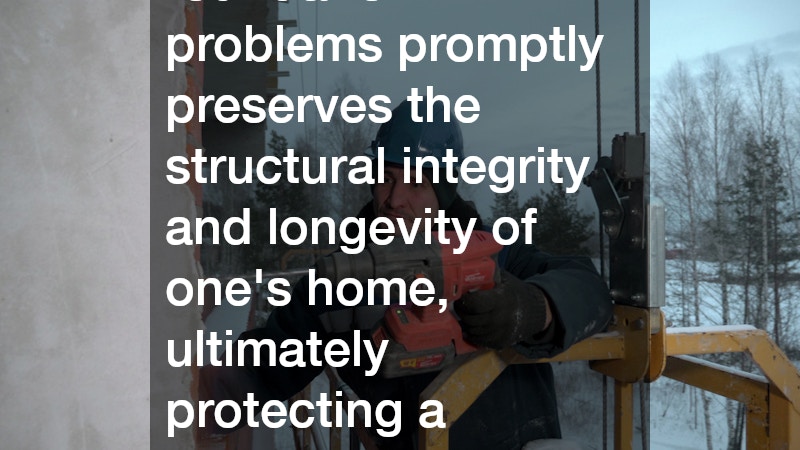The foundation of a home is arguably the most critical part of its structure, serving as a base that supports everything above it. Without a solid foundation, a home can experience a multitude of problems, compromising both safety and property value. As a homeowner, understanding the importance of foundation repairs is crucial to maintaining the integrity of your house and protecting your investment.
What Causes Foundation Problems?
Poor Construction Practices
Poor construction practices can result in foundational weaknesses that manifest over time. When contractors cut corners, such as neglecting to properly compact the soil or failing to reinforce the concrete adequately, the foundation becomes susceptible to cracks and settling.
Moreover, using substandard materials during construction can also compromise the strength and longevity of the foundation.
Improper grading and draining around the perimeter of a home due to construction negligence can lead to poor water management. This eventually results in water pooling, which exerts pressure on the foundation walls and can cause shifts. Over time, these shifts create cracks and gaps that require substantial repair efforts.
Additionally, lack of adherence to engineering specifications and design flaws can wreak havoc on foundational integrity. For instance, inadequate steel reinforcement within concrete supports might lead to flexural cracks. All of these issues stem from unobserved initial workmanship and can ultimately demand costly and extensive repairs.
Soil Conditions
Soil conditions play a direct role in foundation stability due to varying characteristics like expansion and contraction. Expansive soils, commonly known as clay soil, swell with moisture and contract when dry, leading to shifting foundations. This constant movement affects the leveling of the home, often causing visible cracks in walls and floors.
On the other hand, sandy or loamy soil offers less resistance to load-bearing and can lead to sinking or subsidence of the foundation. In areas where soil lacks sufficient load-bearing capacity, the foundation might settle unevenly, creating structural stresses. Soil properties vary regionally, necessitating caution and site-specific engineering during the construction phase to prevent future issues.
Additionally, soil erosion and loss of support due to weather conditions or human activities can contribute to foundation instability. Soil compaction needs to be uniform to prevent weak spots underneath the structure. Proper soil analysis and mitigation measures during and after construction can help address these potential risks.
Weather and Environmental Factors
Seasonal changes significantly impact foundational integrity through freeze-thaw cycles and temperature fluctuations. In cold climates, water becomes frost in the soil, expanding and causing heaving of the foundation during winter. As temperatures warm, the thawing process limits soil support and introduces risks of settling and cracks.
Heavy rainfall and flooding are environmental factors that can also deteriorate foundation stability. Constant exposure to water without proper drainage creates hydrostatic pressure on walls, leading to bowing and eventual cracking. Even in areas without regular flooding, prolonged wet conditions may weaken soil, requiring vigilance and preventative measures.
Moreover, drought conditions cause the soil to contract, presenting another set of challenges that may result in foundation shifts. Severe drought periods can particularly affect clay soil, creating voids that need to be addressed promptly. Homeowners need to monitor these environmental factors continuously to maintain the foundational health of their property.
How Do I Know If My Foundation Needs Repair?
Signs of Foundation Damage
There are several telltale signs that may indicate a foundation in distress. Cracks in walls, uneven floors, and doors or windows that stick are common indicators of foundation issues. Additionally, any visible bowing or bulging of foundation walls should prompt further investigation.
Diagonal cracks in the mortar joint lines are often an indicator of settlement and shifting. Minor hairline cracks might not raise valid concerns; however, vertical or horizontal cracks wider than a quarter-inch can suggest serious structural problems. Procrastination in addressing these signs can lead to more extensive damage over time.
Besides structural discrepancies inside the home, external symptoms might also appear. One such sign is the separation of bricks or façade materials, indicating the foundation is pulling apart. Maintaining vigilance and taking note of these symptoms early can prevent costly future repairs.
Inspection Methods
Professional inspection is an essential step in assessing foundation health and determining necessary repairs. Experts employ advanced tools such as laser levels and devices to measure foundation displacement or movement accurately. These assessments frequently include a thorough evaluation of both internal and external structural integrity, offering homeowners a comprehensive diagnosis.
Infrared thermography is another advanced method, which aids in revealing moisture intrusion within foundation materials. It helps in identifying unseen issues often beneath the surface, such as water leaks or insulation gaps. Advanced inspection methods provide a clear understanding of the underlying problems that aren’t apparent to the naked eye.
Structural engineers might be called upon to execute a detailed analysis of force distribution across the foundation. The insight gained at this stage can determine whether recalibration or underpinning is necessary. Homeowners are advised to conduct inspections periodically and proactively, rather than wait until symptoms appear, to catch potential issues early.
DIY Inspection Tips
While professional evaluation is essential for a full diagnostic, homeowners can conduct basic inspection steps on their own. Regularly checking for visible cracks or gaps in the basement and around the exterior perimeter can provide early warning signs of potential issues. Homeowners should also test the operability of doors and windows, as difficulty in closing them might point to structural shifts.
Using a level, homeowners can measure whether floors are even throughout different parts of the home. Uneven or sloped flooring often indicates settling or foundational movement. Meanwhile, observing any moisture accumulation or pooling water around foundation entry points signals poor drainage or cracks requiring immediate attention.
Foundation issues can have severe implications for homeowners, underscoring the value of timely inspection and repair. With a well-informed understanding of causes, symptoms, and available solutions, property owners can take preemptive measures. Addressing foundation problems promptly preserves the structural integrity and longevity of one’s home, ultimately protecting a significant investment.




